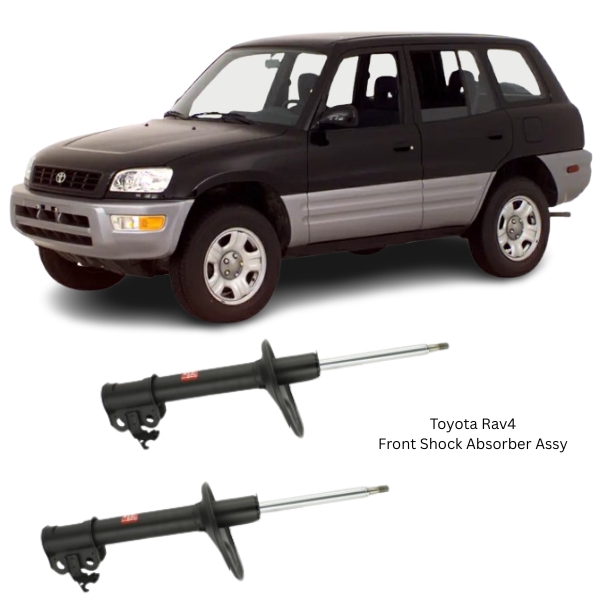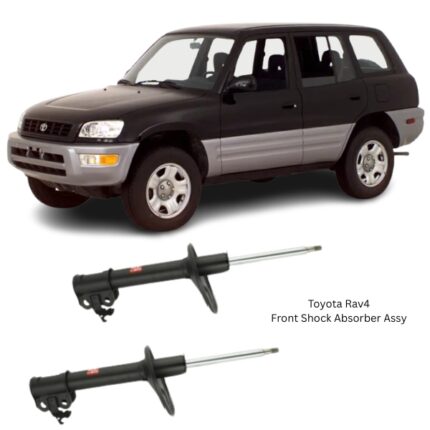Get Toyota Rav4 SXA10/11 Front Shock Absorber Assy 334483 in Kenya
The Front Shock Absorber Assembly is a critical component of the front suspension system designed to absorb and dampen the energy generated by vertical motion from road surfaces. Its primary role is to control the movement of the suspension, keeping the tires in firm contact with the road while enhancing stability, comfort, and overall vehicle safety.
Positioned between the chassis and the lower control arm (or steering knuckle), the front shock absorber assembly is essential in controlling rebound and compression forces caused by road irregularities. It works in harmony with other suspension elements—like coil springs, control arms, bushings, and mounting hardware—to ensure predictable handling and a comfortable ride.
Purpose and Function
The core purpose of the front shock absorber assembly is to:
-
Dampen Oscillations: It reduces the bounce and rebound caused by road imperfections, allowing for smoother travel.
-
Improve Road Holding: Maintains optimal tire-to-road contact, which is crucial for safe braking, steering, and acceleration.
-
Enhance Ride Comfort: Absorbs impacts before they reach the cabin, resulting in a less jarring ride experience.
-
Stabilize Vehicle Movement: Minimizes body roll during cornering, nose-dive under braking, and rear squat during acceleration.
-
Extend Component Lifespan: Reduces wear and tear on tires, suspension joints, and chassis parts by limiting extreme movement.
By converting kinetic energy into heat through hydraulic fluid or gas damping mechanisms, the shock absorber assembly transforms uncontrolled motion into manageable, dissipated force.
Component Structure
The Front Shock Absorber Assembly is built from multiple precision-engineered parts. These include:
1. Shock Body (Outer Tube)
The cylindrical casing made from heavy-duty, corrosion-resistant steel. It houses the internal damping mechanisms and provides structural integrity to withstand road debris and environmental stress.
2. Piston Rod
A hardened steel rod that moves vertically inside the shock body. It connects to the piston at one end and the vehicle frame or mount at the other. Designed to be durable, corrosion-resistant, and capable of withstanding side loads and repeated impact.
3. Piston and Valve System
Located inside the shock tube, this system regulates fluid movement as the shock absorber compresses and rebounds. It determines how quickly or slowly the unit reacts to motion, enabling fine-tuned damping.
4. Hydraulic Fluid or Gas Charge
Shock absorbers either use oil (in hydraulic types) or a combination of oil and nitrogen gas (in gas-charged types) to control movement. Gas-charged types are more resistant to aeration and fade, especially under demanding conditions.
5. Upper and Lower Mounts
These connection points allow the shock absorber to be securely bolted to the chassis and suspension assembly. Rubber bushings or insulators are often used at these joints to reduce vibration and noise transfer.
6. Dust Boot and Bump Stop
A protective sleeve that prevents dirt, mud, and road debris from contaminating the piston rod and seals. The bump stop prevents metal-on-metal contact during full compression, protecting both the shock and the chassis.
Types of Front Shock Assemblies
Shock absorber assemblies come in several configurations based on suspension design:
-
Twin-Tube Design: Features an inner working cylinder and an outer reserve tube. Common in everyday vehicles due to their balance of comfort and performance.
-
Mono-Tube Design: Uses a single cylinder with a floating piston separating gas and oil. Offers better heat dissipation and consistent performance.
-
Strut-Type Assemblies: Combines the shock absorber and coil spring into one unit. In such systems, the shock not only dampens motion but also bears vehicle load and maintains wheel alignment geometry.
Performance Characteristics
The effectiveness of a front shock absorber is judged by its ability to:
-
Adapt to varying road surfaces in real-time.
-
Maintain consistent damping regardless of load or temperature.
-
Provide adequate resistance during both compression (bump) and rebound phases.
-
Remain leak-free and structurally intact over thousands of kilometers of use.
Signs of Wear or Failure
As a wear-and-tear component, the front shock absorber should be inspected regularly. Common indicators of failure include:
-
Increased Bouncing: After hitting a bump, the vehicle continues to oscillate excessively.
-
Nose Diving: The front end dips sharply during braking.
-
Steering Instability: The steering wheel feels loose or the vehicle drifts in crosswinds or on turns.
-
Leaking Fluid: Oil or residue on the shock body indicates internal seal failure.
-
Uneven Tire Wear: Especially cupping or scalloping patterns due to uncontrolled suspension movement.
-
Noisy Operation: Clunking or rattling sounds may suggest worn-out bushings or internal damage.
Replacing worn shocks promptly is essential to prevent further damage to suspension and braking systems and to maintain safe driving characteristics.
Installation Guidelines
The front shock absorber assembly can be replaced with basic mechanical knowledge, though professional installation is recommended. Key steps include:
-
Lifting the Vehicle: Secure the vehicle on a level surface using jack stands.
-
Removing the Wheel: Allows access to the suspension components.
-
Disconnecting Upper and Lower Mounts: Typically secured by bolts or nuts.
-
Removing the Old Assembly: May require separating the shock from the control arm or knuckle.
-
Installing the New Unit: Aligning the shock properly, securing all hardware to manufacturer torque specifications.
-
Performing Wheel Alignment: Necessary in strut-type setups to avoid misalignment and uneven tire wear.
Maintenance and Lifespan
Though generally maintenance-free, shock absorbers should be inspected every 20,000–30,000 km or during regular servicing. Their lifespan typically ranges from 60,000 to 100,000 km, depending on:
-
Driving Habits: Aggressive driving shortens lifespan.
-
Load Carrying: Frequent heavy loads put extra stress on shocks.
-
Road Conditions: Rough, unpaved roads accelerate wear.
-
Climate: Extreme temperatures affect seals and fluid viscosity.
Timely replacement ensures optimum performance and reduces long-term repair costs.
Benefits of a Healthy Front Shock Absorber Assembly
A well-functioning front shock absorber delivers the following benefits:
-
Improved Ride Quality: Absorbs shocks and minimizes vibrations felt in the cabin.
-
Enhanced Handling: Provides stability during cornering, braking, and acceleration.
-
Increased Safety: Ensures better braking efficiency and control in emergency situations.
-
Reduced Component Wear: Protects tires, bushings, control arms, and other suspension parts.
-
Quiet Operation: Eliminates rattles and harsh feedback from the road surface.
Whether on city roads, off-road trails, or highways, a quality front shock absorber plays a vital role in vehicle dynamics.
Environmental Considerations
Replacing a failing front shock absorber not only restores ride comfort and handling but also contributes to fuel efficiency and lower emissions. Poorly functioning shocks can increase rolling resistance and strain other vehicle systems.
Follow us on Facebook for more parts.




